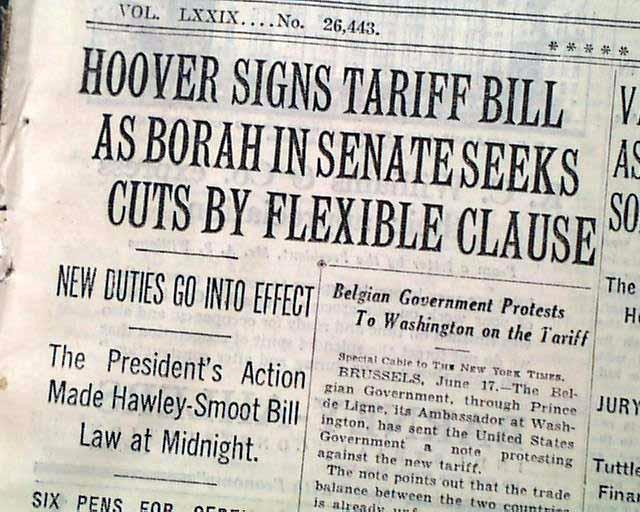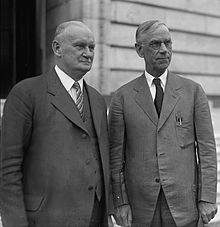270 1828 United States Constitution. Smoot-Hawley Tariff Act formally United States Tariff Act of 1930 also called Hawley-Smoot Tariff Act US.
 The Tariff Act Of 1930 Codified At 19 U S C Ch Sutori
The Tariff Act Of 1930 Codified At 19 U S C Ch Sutori
The general level of rates is appre-ciably higher than that of the law of 1922.

Tariff act of 1930. - Minor agricultural products 9. According to the Encyclopedia of the American Constitution about its article titled Tariff Act 4 Stat. Legislation in the United States passed in 1930 that raised tariffs on thousands of imports.
Its passage was essentially a response to domestic unemployment during the Depression and protectionist forces in the agricultural and. Section 307 of the Smoot-Hawley Tariff Act of 1930 19 USC. 3 TARIFF ACT OF 1930 Sec.
- Hides wool meat and dairy products 7. AGRICULTURAL TRADE PROGRAMS AND POLICIES AFFECTING DOMESTIC AND FOREIGN GOVERNMENT UNITED STATES TARIFF COMMISSION. 2 A license in effect on the date of enactment of this Act Oct.
The Act also provides for a basic statutory authority to the US. -Higher duties on agricultural commodities such as sugar wheat cotton 3. If articles are excepted from marking requirements under clause F G or H of subdivision 3 of subsection a of this section their usual containers shall not be subject to the marking requirements of this section.
Commanding position of the Conference Committee. NOVEMBER 1930 THE TARIFF ACT OF 1930 SUMMARY The final settlement. - Manufactured articles cottons woolens silks 13- The general trend 16.
All goods wares articles and merchandise mined produced or manufactured wholly or. SUBTITLE IHARMONIZED TARIFF SCHEDULE OF THE UNITED STATES 1202 SUBTITLE IISPECIAL PROVISIONS 1301 1367 SUBTITLE IIIADMINISTRATIVE PROVISIONS 1401 1654 SUBTITLE IVCOUNTERVAILING AND ANTIDUMPING DUTIES 1671 1677n. Subsection b of such Public Law provides.
In form it is much like its predecessor. Legislation June 17 1930 that raised import duties to protect American businesses and farmers adding considerable strain to the international economic climate of the Great Depression. Known as the Tariff of Abominations this act was designed to embarrass john quincy adams and help andrew jackson win the PresidencyJacksonians controlling the House Committee on.
Tariff Act of 1930 as Amended Under Section 332 of the Report on Investigation No. Import duties with the goal of protecting American farmers and other industries from foreign competition. Tariff Act of 1930 Tariff Act 4 Stat.
701 TARIFF ACT OF 1930 246 41 Section 1a of Public Law 11299 adds a new subsection f to section 701. TARIFF ACT OF 1930 CHAP497An Act To provide revenue to regulate commerce with foreign countries to encourage the industries of the United States to protect American Labor and for other purposes. The flexible provision which appeared in the Act of 1922 is retained and on this provision President Hoover relies to reduce.
Also known as the Smoot- Hawley Act this established the highest rates of duty ever imposed by the United States. Be it enacted by Senate and House of Representatives of the United States of America in Congress assembled Title IHARMONIZED TARIFF SCHEDULE. THE TARIFF ACT OF 1930 The Tariff act of 1930 is partly an outcome of the post-war agricultural depres-sion.
However the Act is considered to have been a failure because it led to retaliatory measures in foreign countries which reduced US. 30 1984 under section 641 of the Tariff Act of 1930 as in effect before such date of enactment shall continue in force as a license to transact customs business as a customs broker subject to all the provisions of section 212 and such licenses shall be accepted as permits for the district or districts covered by that license. B EFFECTIVE DATESubsection f of section 701 of the Tariff Act of 1930 as added by sub-section a of this section applies to.
International Trade Commission ITC to conduct general fact-finding investigations and issue reports on any matter relating to trade. The Tariff Act of 1930 Act is a federal legislation providing for a harmonized tariff schedule in the US. The idea behind the Act was to protect American jobs especially those of farmers from cheap imports.
The Smoot-Hawley Tariff Act of 1930 raised US.